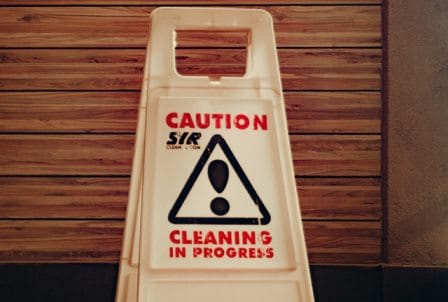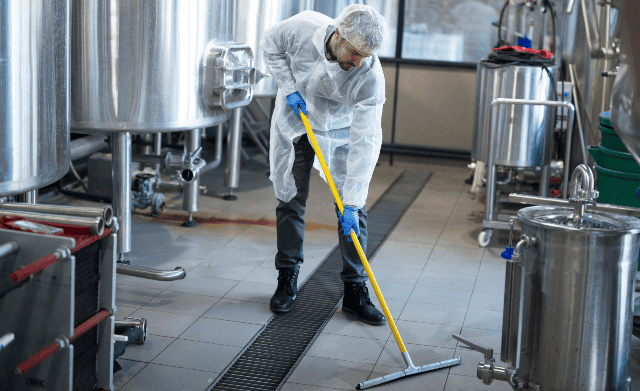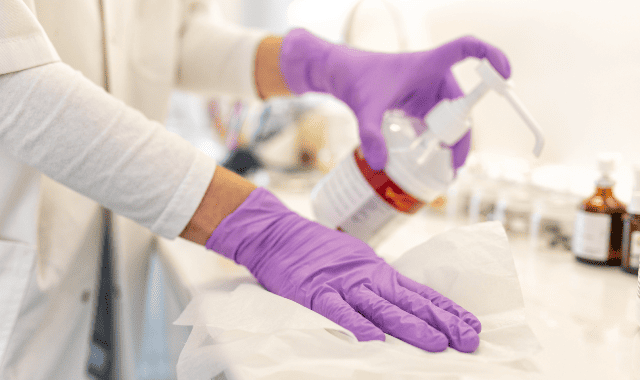
Good housekeeping practices in GMP
- Kazi
- Last modified: March 13, 2025
Good housekeeping practices include establishing cleaning procedures and schedules to ensure washrooms and toilet facilities are properly maintained.
Also, please set up procedures to ensure the safe and sanitary disposal of trash and other refuse within and from the Buildings and immediate premises.
Department Heads and Supervisors are responsible for indoctrinating and training employees in good housekeeping habits.
This article is to help all personnel maintain a state of alertness to make sure that the plant housekeeping is always kept at the peak of efficiency.
All personnel, without exception, must do everything possible to maintain the quality of housekeeping expected and required in a pharmaceutical operation.
Table of Contents
Who is responsible for housekeeping?
All staff in a production and laboratory environment are collectively responsible for maintaining good housekeeping practices.
Housekeeping schedule
The QA manager is responsible for ensuring that housekeeping schedules are maintained and work is performed satisfactorily.
Approval of cleaning compounds
The quality assurance manager is responsible for approving cleaning compounds that are safe to use during housekeeping cleaning activities.
Some of the commonly used cleaning compounds in pharmaceutical facilities are:
– Ammonia solution
– Liquid pine detergent
– Detergent
– Bactericide powdered cleaner
– Strong bowl cleaner
Accumulation of trash and waste
The QA team prepares procedures to instruct how to place all trash and waste in the receptacles and accumulate empty drums and other discarded materials in the designated areas.
Product wastes, trash, and other refuse should be accumulated in suitable containers and designated areas and disposed of consistent with local codes and ordinances.
The QA team and the process operators check all areas daily and empties waste paper baskets and other refuse containers into plastic bags, fiber drums, or metal trash bins.
Then, remove accumulated wastes, empty fiber, and metal drums, broken pallets, and other discarded materials to a designated disposal area.
They should place all discarded cardboard, paper, and corrugation from the Packaging Dept. in the compactor.
Disposal of waste
The quality assurance team is responsible for providing suitable sanitary receptacles for accumulating trash, refuse, and product waste and ensuring that they are removed and disposed of appropriately.
Receiving bay
As a good housekeeping practice, the warehouse staff should accumulate returned products in appropriately marked containers.
Quality assurance inspectors destroy all unused labels and inserts from the Packaging Lines.
Cleaning rejects from production and laboratory
Production operators are responsible for putting all line rejects, waste caps, plastic bottles, glass, and waste products in appropriately marked containers.
Accumulate rejected and imperfect goods in the designated area.
Laboratory personnel collect all solvents, corrosive materials, and other liquid waste not permitted in the sewer in appropriately marked containers and notify the quality assurance department.
250 SOPs, 197 GMP Manuals, 64 Templates, 30 Training modules, 167 Forms. Additional documents are included each month. All written and updated by GMP experts. Check out sample previews. Access to exclusive content for an affordable fee.
General housekeeping practices
Housekeeping practices in a pharmaceutical facility have the same connotation as housekeeping in a home. Good housekeeping practices in the house or a GMP facility require everyone’s cooperation to maintain the premises clean and orderly.
The basic facility cleaning is carried out by service personnel during work periods. This includes sweeping, vacuuming, mopping, and dusting as required in the different areas.
This, however, still leaves room for the little “extra” required to create a spotless establishment.
Only the personnel can supply this little “extra” which includes such various and diverse aspects of housekeeping as:
– Picking up a piece of paper
– Wiping off a dusty spot
– Immediately cleaning up of spilled materials
– The orderly arrangement of boxes, cartons, drums, and equipment in the work areas.
Housekeeping practices in pharmaceutical production
Good housekeeping practices in the pharmaceutical production area are essential for ensuring product quality.
Here are some standard housekeeping practices you should use for the pharmaceutical production setting:
1. Cleanroom protocols
Ensure all employees are trained to follow strict cleanroom protocols, including wearing appropriate personal protective equipment (PPE) such as gowns, gloves, and hairnets.
Regularly clean and sanitize cleanroom surfaces to prevent contamination.
2. Gowning procedures
Enforce strict gowning and change room procedures for personnel entering production areas.
Could you provide regions designated for changing into cleanroom attire and make sure that employees follow proper gowning protocols?
3. Material segregation
Implement a robust system for segregating raw materials, intermediates, and finished products.
Clearly label and store materials in designated areas to prevent cross-contamination and mix-ups.
4. Equipment cleaning and maintenance
Could you set up a routine schedule for cleaning and housekeeping of production equipment?
Regularly inspect and sanitize machinery to prevent the build-up of residues and ensure optimal equipment functioning.
5. Floor and surface cleaning
Regularly clean floors, walls, and surfaces in the production area. Use suitable cleaning agents and disinfectants to maintain a graded environment.
6. Waste management
Please make sure everyone follows proper waste disposal procedures for pharmaceutical waste.
Dispose of waste following regulatory guidelines and ensure designated bins are available for different types of garbage.
7. Labelling and documentation
Clearly label all containers, equipment, and production areas.
Please maintain accurate documentation of cleaning schedules, procedures, and any deviations encountered during the cleaning process.
8. Personnel hygiene
Could you emphasize personal hygiene practices among production staff?
Your production staff must wash their hands thoroughly before entering the production area and adhere to proper gowning procedures.
9. Spill response plans
Develop procedures for spill response in the production area and train personnel adequately.
Clearly outline procedures for managing spills of chemicals or pharmaceutical materials to minimize the impact on personnel safety and product quality.
10. Regular audits and inspections
Please conduct routine audits and inspections of the production area to identify and address any potential housekeeping issues quickly.
Regular checks help maintain compliance with regulatory standards.
11. Pest control
Implement measures to prevent pest infestations, such as regular inspections, sealing entry points, and maintaining a clean environment that minimizes attractants for pests.
250 SOPs, 197 GMP Manuals, 64 Templates, 30 Training modules, 167 Forms. Additional documents are included each month. All written and updated by GMP experts. Check out sample previews. Access to exclusive content for an affordable fee.
Housekeeping practices in the laboratory
The pharmaceutical laboratory is one of the busiest areas where regular cleaning and housekeeping are essential to ensure the samples are not contaminated.
Good housekeeping is one of the basic requirements to certify your test results are free from bias.
1. General housekeeping practices in the laboratory
Cleanliness is key for pharmaceutical product quality.
Please maintain your laboratory spaces at a top-notch GMP/GLP level, ensuring doorways, aisles, and traffic ways remain obstructed.
A clutter-free work area, including workbenches and instrument rooms, is important. Promptly wipe up any spillages to keep benchtops and floors clean.
Storage areas, from document filing to chemical storage cabinets, should be kept clean and tidy.
Please remember to lock the filing compacts when they are left unattended.
Please remember to turn off the gas burner and water outlets when used, and keep the fume hoods orderly.
Regularly empty, scrub, and refill water and ultrasonic baths to maintain hygiene.
Efficient waste management is vital. You can find a good instruction in the standard operating procedure “Disposal of rejected and waste materials.”
Dispose of wastepaper in designated bins, to be emptied by contract cleaners.
2. Chemicals and Reagents
Organize your chemicals and reagents. If you need help, follow the procedure “Managing Analytical reagents.”
Ensure everyone knows what’s where. In case of spills, clean the affected areas promptly.
3. Emergency facilities
Always keep emergency facilities functional and accessible.
This includes fire extinguishers, safety showers, eyewash fountains, emergency exit signs, and spill kits.
Clear access ensures a quick response in case of unforeseen situations.
4. Housekeeping inspections
Monthly housekeeping inspections are a proactive measure.
Follow the laboratory housekeeping inspection checklist to ensure compliance with the procedure. Record your findings on the housekeeping audit check sheet for laboratory.
Proactively address any non-compliance. Record corrective actions and verification of completion, and keep the record in the designated folder.
5. Cleaning of glassware
Could you rinse dirty glassware thoroughly and use designated areas based on volume?
Following a structured process for collecting, cleaning, and storing glassware ensures a seamless workflow.
6. Pipette Management
Pipette handling requires precision.
Rinse pipettes after every use. Please place them in designated holders and change the holder solution weekly.
A meticulous cleaning process involving dishwashers and alcohol solutions ensures the reliability of your laboratory equipment.
Housekeeping practices for contractors
Mechanics, contractors, and their employees have to work inside clean production areas whenever a machine breaks down.
Installing new equipment and processes requires mechanics to work for a period inside designated GMP facilities. All contractors must follow strict housekeeping practices until machine repair or other projects are completed.
Mechanics and contractors must always follow the rules within the production areas. Such as:
1. Notify the Supervisor of the work to be performed and obtain permission to proceed.
2. Wear an appropriate head covering at all times.
3. Place appropriate coverings over adjacent materials and equipment if work is on walls or overhead areas.
4. Refrain from smoking, eating, drinking, or spitting in the area.
5. Keep tools and other work-related materials off equipment, drum tops, or other materials in the area.
6. Use a suitable screen to isolate burning or welding operations and ensure adequate ventilation.
Note: No welding or burning operations will be done in areas with exposed bulk or uncapped products.
7. Clean up all debris when work is completed and discard it into appropriate containers.
8. Notify the Area Supervisor that the work is complete.
Washroom housekeeping practices
Washrooms are critical to maintaining good housekeeping in pharmaceutical facilities.
You should maintain all washrooms in a sanitary condition with an adequate supply of hot and cold running water, soap or detergent, and single-use disposable towels or hot-air dryers.
1. Prepare SOP for housekeeping
i. Prepare standard operating procedures for washroom hygiene and ensure all employees follow the procedure.
ii. Select and train personnel in the methods and procedures for cleaning and sanitation.
iii. Ensure an adequate supply of approved cleaning and sanitizing compounds exists.
iv. Could you set up cleaning schedules and monitor their effectiveness?
v. Service personnel are responsible for carrying out their assigned duties.
vi. Supervisors are responsible for monitoring their respective areas and promptly reporting any unsatisfactory conditions, taking disciplinary action when necessary for violation of rules concerning the use of washroom facilities.
2. Clean wash basins daily
i. Sprinkle some detergent into the basin.
ii. Wet an appropriate cleaning device with water.
iii. Use a detergent solution with the cleaning device to wash the inside and outside basins, all handles, faucets, and pipes.
iv. Could you rinse thoroughly with warm water?
3. Service dispensers and receptacles daily
i. Clean and refill paper towel receptacles and toilet paper holders.
ii. Empty and clean sanitary and trash disposable receptacles.
iii. Fill soap dispensers.
4. Clean urinals daily
i. Flush urinal.
ii. Add detergent to urinal
iii. You can use an appropriate cleaning device to wash inside, around, and under the lip of the urinal.
iv. Flush urinal
5. Clean toilet bowls daily
i. Flush toilet
ii. Add detergent to bowl.
iii. Use an appropriate cleaning device to wash inside and outside of the bowl and around and under the lip.
iv. Wipe the toilet seat and lids.
v. Flush toilet.
6. Clean floors daily
i. Use a cleaning solution with a wet mop to wash floors. Pick up the excess.
ii. If floors are very dirty, use a detergent solution for washing.
7. Bleach toilet bowls and urinals once per week
i. Could you clean with a strong bowl cleaner according to the directions for use?
8. Clean tile walls and partitions once per month
i. You can use a cleaning solution to wash tiles and partitions.
9. Clean light fixtures and overhead semi-annually
i. Could you wash light fixtures with a cleaning solution?
ii. You can use a treated dust cloth to wipe ledges, shelves, and all areas above.
250 SOPs, 197 GMP Manuals, 64 Templates, 30 Training modules, 167 Forms. Additional documents are included each month. All written and updated by GMP experts. Check out sample previews. Access to exclusive content for an affordable fee.
Disposal of trash and waste
1. Compact all waste materials into the containers provided by the Contract Garbage Disposal Company.
2. Remove accumulated broken wooden pallets.
3. When necessary, please make sure to dispose of empty metal drums.
4. Corroborate with quality control and quality assurance to supervise the destruction of returned goods, samples, rejected goods, and imperfect goods.
5. Deliver liquid wastes not permitted in the sewers to a licensed and regulated service for disposal.
Conclusion
In conclusion, this article demonstrates the critical role of housekeeping practices in pharmaceutical operations and signifies their impact on safety, efficiency, and overall quality.
The guidelines provided cover various areas within a pharmaceutical facility.
For the production facilities, good housekeeping practices include clearly defined cleanroom protocols, gowning procedures, and material segregation.
It also highlights the necessity for routine equipment cleaning, floor maintenance, waste management, and rigorous adherence to labeling, personnel hygiene, and spill response plans.
Within the laboratory, the focus is on maintaining a clutter-free and clean workspace. The article provides:
– Guidance on organizing chemicals and reagents.
– Ensuring emergency facilities are functional.
– Implementing thorough glassware cleaning processes.
Monthly housekeeping inspections and adherence to waste disposal protocols are also emphasized.
For washrooms, a standard operating procedure for maintaining hygiene is outlined.
The article details a daily cleaning routine for various fixtures and emphasizes proper trash and waste disposal according to regulatory guidelines.
The article highlights the need for strict adherence to housekeeping practices in workshops or when working with contractors.
It would be best to remind mechanics and contractors to follow specific rules, including notifying supervisors, wearing appropriate protective gear, and ensuring proper cleanup after completing work.
Pharmaceutical facilities can establish and maintain a clean, organized, and compliant environment by following these comprehensive guidelines in each area.
Such efforts contribute not only to regulatory compliance but also to the overall success and reputation of the operation.

Author: Kazi Hasan
Kazi is a seasoned pharmaceutical industry professional with over 20 years of experience specializing in production operations, quality management, and process validation.
Kazi has worked with several global pharmaceutical companies to streamline production processes, ensure product quality, and validate operations complying with international regulatory standards and best practices.
Kazi holds several pharmaceutical industry certifications including post-graduate degrees in Engineering Management and Business Administration.


